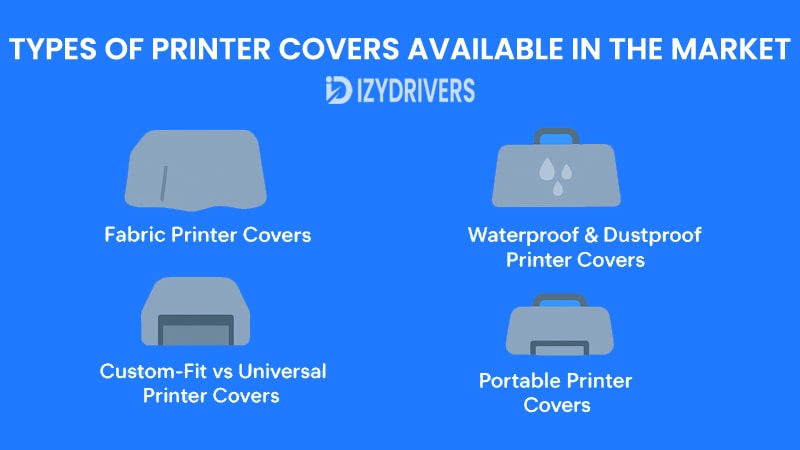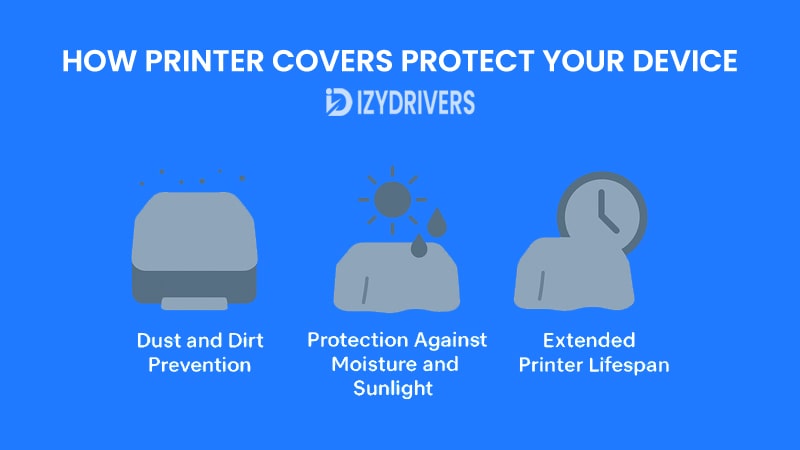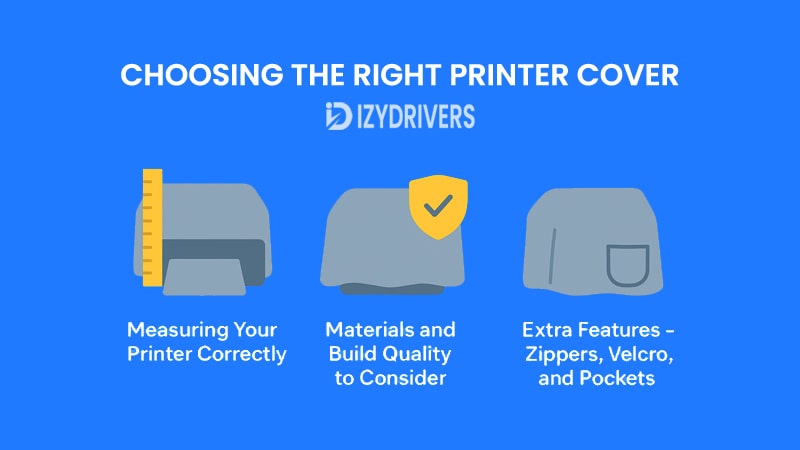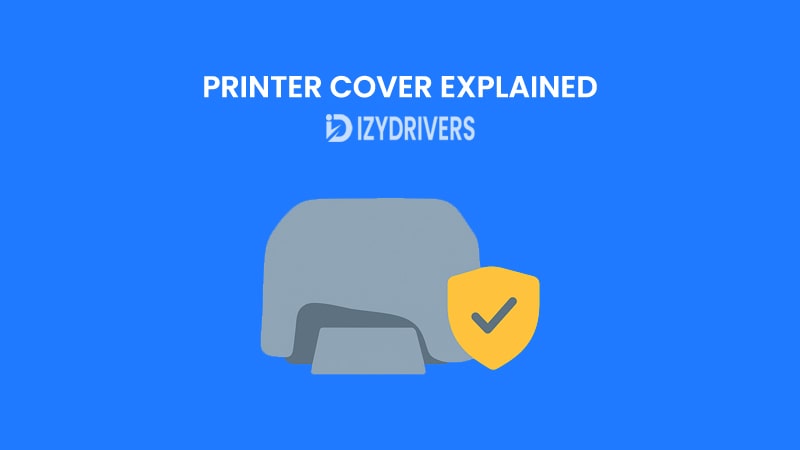Printers are workhorses. They sit quietly in a corner until you need them—printing reports, photos, forms, or that last-minute project before a deadline. Yet most people rarely think about their printer’s well-being until something goes wrong. Paper jams, dust buildup, or fading print quality often seem like sudden problems, but in reality, they build up over time. One simple way to prevent many of these issues? A printer cover.
A printer cover might look like a simple accessory, but it plays a bigger role than you think. It keeps dust, moisture, and sunlight away from delicate internal components, extending your printer’s lifespan and reducing maintenance headaches. Whether you use a compact inkjet at home or a heavy-duty laser printer at the office, a well-chosen printer cover can save you time, money, and frustration in the long run.
In this guide, we’ll break down everything you need to know—from the types of printer covers available to how they work, what features to look for, and even DIY options if you prefer a personal touch. By the end, you’ll know exactly which printer cover suits your needs and how to make the most of it.
What Is a Printer Cover and Why You Need One
Printer Cover Basics – Function and Purpose
A printer cover is exactly what it sounds like—a protective layer designed to shield your printer from environmental factors that can cause damage over time. It may seem like a simple accessory, but its purpose goes beyond aesthetics. Many people underestimate how quickly dust, debris, and even sunlight can harm sensitive printer components. Once dust settles inside the machine, it can clog moving parts, interfere with sensors, and lead to poor print quality.
The main function of this parts is to act as a barrier. Whether it’s made of fabric, vinyl, or waterproof materials, a good cover ensures your printer stays protected when not in use. This simple addition can drastically reduce the risk of frequent repairs and even extend the overall lifespan of the device. In other words, a printer cover is a small investment that prevents big problems down the road.
Key Benefits of Using a Printer Cover
The benefits of using a this parts go beyond dust prevention. For home users, it means less time spent cleaning and fewer maintenance calls. For office environments where printers run all day, it ensures that downtime due to technical issues remains minimal.
Moreover, many modern printer covers come with features like water resistance, UV protection, and even custom-fit designs that perfectly match your printer’s dimensions. These features protect against accidental spills, sunlight exposure that can fade plastics, and even curious pets or kids at home. By keeping the printer safe, a printer cover indirectly keeps your workflow uninterrupted—something businesses especially value.
Types of Printer Covers Available in the Market

Printer covers are not one-size-fits-all. They come in different materials, designs, and protection levels, each made for specific needs. Choosing the right printer cover depends on where you use your printer, how often, and what kind of risks it faces—dust, water, sunlight, or even scratches.
Fabric Printer Covers – Affordable and Simple
Fabric printer covers are the most basic and affordable option on the market. Made from materials like cotton or polyester, these covers offer light protection against dust and dirt. They are ideal for home users or small offices where printers aren’t exposed to extreme conditions.
The main advantage is affordability and flexibility. Fabric covers are easy to remove, washable, and available in multiple colors or patterns. However, they don’t provide strong protection against water or sunlight. So, if your printer sits near a window or in a humid environment, you might want something more durable than a basic fabric printer cover.
Waterproof & Dustproof Printer Covers – Maximum Protection
For environments with high dust levels or potential water exposure, waterproof and dustproof printer covers are the best choice. Usually made of vinyl or heavy-duty polyester with a water-resistant coating, these covers ensure that nothing penetrates the surface.
They are particularly useful for factories, workshops, or offices near open windows where dust and moisture can be a problem. The durability also means they last longer, even with heavy use. Many of these covers include tight closures like zippers or Velcro straps, ensuring a snug fit that leaves no room for dust to sneak in.
Custom-Fit vs Universal Printer Covers – What’s the Difference?
Here’s where many users get confused: should you buy a custom-fit printer cover designed for your exact printer model, or go for a universal cover that fits multiple sizes?
- Custom-Fit Printer Covers: Made specifically for your printer model, offering perfect coverage and a neat look. They cost more but provide better protection since they leave no gaps.
- Universal Printer Covers: More affordable and adjustable, but might not offer the same snug fit. Still, they work well for common printer sizes and models.
Portable Printer Covers – Protection on the Go
For people who use portable printers—common among students, photographers, or traveling professionals—portable printer covers are essential. These covers often double as carrying cases, offering protection while also making transportation easy.
Portable printer covers typically include padding, water-resistant layers, and compartments for cables or paper, so you can carry everything in one bag. They’re designed with mobility in mind, so they prioritize convenience as much as protection.
Types of Printer Covers and Their Key Features
| Type of Printer Cover | Material | Protection Level | Best For | Price Range |
|---|---|---|---|---|
| Fabric Printer Cover | Cotton/Polyester | Basic Dust Protection | Home Use, Low-Dust Areas | $10 – $20 |
| Waterproof & Dustproof Cover | Vinyl/Heavy Polyester | High Dust & Water Protection | Workshops, Factories, Humid Areas | $20 – $40 |
| Custom-Fit Printer Cover | Varies (Model-Specific) | Perfect Fit & Full Coverage | Offices, Expensive Printers | $25 – $50 |
| Universal Printer Cover | Adjustable Materials | General Coverage | Multiple Printers, Budget Buyers | $15 – $30 |
| Portable Printer Cover | Padded/Waterproof | Travel & Transport Safety | Students, Traveling Professionals | $30 – $60 |
How Printer Covers Protect Your Device

Printer covers might look simple, but the level of protection they offer can make a big difference in how long your printer lasts and how well it performs. Different environmental factors affect printers in different ways, and a printer cover helps minimize these risks effectively.
Dust and Dirt Prevention
Dust is one of the biggest enemies of any printer. It can sneak into small gaps, settle on mechanical parts, and eventually cause misfeeds or print quality issues. Over time, dust particles can interfere with sensors, printer rollers, and even ink nozzles, leading to expensive repairs.
A printer cover acts as a barrier between your printer and airborne particles. Whether you keep your printer in a home office near an open window or in a workplace with constant foot traffic, dust will always be present. By covering your printer when it’s not in use, you greatly reduce the amount of dirt entering the device. This simple habit can prevent many common issues before they even start.
Protection Against Moisture and Sunlight
While dust causes mechanical problems, moisture and sunlight can damage both the exterior and internal components of a printer. Moisture can lead to corrosion, while prolonged exposure to sunlight can fade plastic parts and even cause overheating.
Many high-quality printer covers come with water-resistant materials that shield against accidental spills or humid air. For printers placed near windows, UV-resistant covers prevent sunlight from degrading the printer’s casing and internal printer parts. This added layer of protection ensures your printer stays in good condition, even in challenging environments.
Extended Printer Lifespan
Preventing dust, moisture, and sunlight damage isn’t just about avoiding short-term problems—it’s about long-term savings. A well-maintained printer can last several years longer than one exposed to constant wear and tear.
By investing in a reliable printer cover, you’re essentially extending the lifespan of your device. Less frequent breakdowns mean fewer repair costs, less downtime, and better performance over time. For offices with multiple printers, this small accessory can lead to significant cost savings in the long run.
Choosing the Right Printer Cover for Your Needs

Selecting the right printer cover isn’t just about picking the first one you see online. Every printer has different dimensions, working conditions, and protection needs. A poorly fitted cover might fail to protect your printer or become an inconvenience during everyday use. In this section, we’ll break down the key factors to consider before buying the perfect printer cover for your device.
Measuring Your Printer Correctly
One of the most common mistakes people make is buying a printer cover without checking the printer’s exact size. Every printer model comes with unique dimensions, and choosing the wrong size means either the cover won’t fit properly or it will leave gaps that let dust and moisture inside.
Before you buy, measure the following:
- Width: From the left edge to the right edge of the printer.
- Depth: From the front to the back of the printer.
- Height: From the base to the highest point, often the scanner lid or paper feeder.
Some printer cover manufacturers provide size charts based on popular printer models, which can save you time and ensure a snug fit without guesswork.
Materials and Build Quality to Consider
Not all this parts are created equal. The material you choose directly affects the level of protection your printer receives.
- Fabric: Lightweight, washable, and budget-friendly. Great for homes or clean office environments.
- Vinyl: Durable and water-resistant, ideal for preventing accidental spills.
- Heavy-Duty Polyester: Often coated with waterproof or UV-resistant layers, perfect for dusty or humid locations.
Pay attention to details like stitching quality and closure systems. High-quality covers often feature double-stitched seams and reinforced edges for better durability.
Extra Features – Zippers, Velcro, and Pockets
Some printer covers include additional features designed for convenience:
- Zippers: Allow easy access to the printer without removing the entire cover.
- Velcro Straps: Help secure the cover tightly and adjust the fit.
- Storage Pockets: Useful for keeping spare ink cartridges, cables, or small tools handy.
These extras aren’t essential, but they can make day-to-day use much smoother, especially in busy office environments where printers are used frequently.
Top Brands and Recommendations for Printer Covers
With so many printer cover options available, choosing the right one can feel overwhelming. Some brands focus on affordability, while others prioritize premium materials and durability. The best choice depends on your budget, printer type, and the level of protection you need.
Below, we highlight a few popular options across different price ranges and protection levels. This will help you quickly narrow down the choices and find a printer cover that fits your specific needs.
Best Budget Printer Covers
If you need basic protection without spending too much, several budget-friendly brands offer durable covers for everyday use. These covers are usually made of fabric or lightweight polyester, providing decent dust protection at an affordable price point.
While they may lack advanced features like waterproofing or UV resistance, they’re perfectly fine for home users or low-dust environments where heavy-duty protection isn’t essential.
Premium Printer Cover Options
For those willing to invest more, premium printer covers come with high-quality materials like heavy-duty polyester or vinyl, waterproof coatings, and UV protection. Many of these also offer custom-fit designs for specific printer models, ensuring maximum coverage and a professional look.
Some brands even include extras like storage pockets, zipper access, and reinforced stitching for longer lifespan and convenience. These are ideal for offices, industrial settings, or users who want the best protection for their expensive printers.
Top Printer Cover Brands and Key Features
| Brand/Model | Material Type | Protection Level | Fit Type | Price Range | Best For |
|---|---|---|---|---|---|
| DustShield Basic Cover | Polyester Fabric | Basic Dust Protection | Universal Fit | $10 – $20 | Home Users, Light Office Use |
| PrinterGuard Waterproof | Vinyl + Coating | Waterproof & Dustproof | Custom Fit | $20 – $35 | Offices, Moderate Dust Environments |
| CoverMate Heavy Duty Pro | Heavy-Duty Polyester | Dust + UV + Water Resistant | Custom Fit | $30 – $50 | Industrial Use, High-Dust Areas |
| UniFit Printer Cover | Adjustable Fabric | General Coverage | Universal Fit | $15 – $25 | Multiple Printers, Budget Buyers |
| TravelPrint Portable Cover | Padded & Waterproof | Portable Protection | Portable Fit | $35 – $60 | Students, Professionals on the Go |
DIY vs Store-Bought Printer Covers
When it comes to printer covers, you don’t always have to buy one from the store. Some people prefer the DIY route to save money or create a personalized look. But is it really worth it? Let’s break down the pros and cons of DIY printer covers compared to buying ready-made options so you can decide which one fits your needs best.
Pros and Cons of DIY Printer Covers
Making your own cover can be an attractive idea, especially if you enjoy craft projects or want to customize the design to match your office décor.
Pros
- Cost Savings: If you have leftover fabric at home, you can make a basic cover for almost no cost.
- Customization: Choose any color, pattern, or size you want for a unique look.
- Eco-Friendly: Reusing materials helps reduce waste and promotes sustainability.
Cons
- Time-Consuming: Designing, cutting, and sewing a cover can take hours, especially if you’re not experienced.
- Durability Concerns: Homemade covers may lack professional-quality stitching or protective coatings like waterproof layers.
- Limited Features: Most DIY covers won’t include zippers, UV protection, or reinforced seams unless you invest extra effort and materials.
When to Buy Instead of Making Your Own
For busy professionals or people who need advanced protection, buying a printer cover is usually the better choice. Store-bought covers often come with benefits that DIY versions can’t easily replicate:
- Professional Fit: Ready-made covers are designed to fit specific printer models perfectly, ensuring full coverage.
- Advanced Protection: Many commercial covers offer waterproofing, UV resistance, and padded layers for added safety.
- Convenience: No need to spend time sewing or experimenting—just order, unpack, and use.
In short, DIY printer covers are fine for light protection or aesthetic purposes, but if your printer is valuable or located in a challenging environment, a store-bought version will save you time and provide better long-term reliability.
Caring for Your Printer Cover
Buying a printer cover is just the first step. To make sure it lasts and continues protecting your printer effectively, proper care and maintenance are essential. Many people forget that covers themselves collect dust and dirt over time, so keeping them clean will extend both their life and the life of your printer.
Cleaning and Maintenance Tips
Most printer covers are easy to clean, but the method depends on the material:
- Fabric Covers: These are usually machine-washable. Use mild detergent and cold water to avoid shrinking or fading. Always air dry instead of using a dryer to prevent damage.
- Vinyl or Polyester Covers: Wipe them down with a damp cloth and mild soap. For waterproof covers, avoid harsh chemicals that might strip the protective coating.
Cleaning your printer cover at least once a month keeps dust from accumulating and prevents mold or unpleasant odors if you live in a humid environment.
How Often Should You Replace a Printer Cover?
Even high-quality covers don’t last forever. Over time, zippers can wear out, fabric can fray, and coatings can lose their effectiveness. A general rule is to replace your cover every 1–2 years, or sooner if you notice:
- Tears or holes in the fabric.
- Reduced water resistance or fading from sunlight exposure.
- Poor fit due to repeated stretching or washing.
Regular replacement ensures your printer continues to get the best protection possible.
Cost vs Value – Are Printer Covers Worth It?
Many people hesitate before buying a printer cover because it feels like an extra accessory rather than a necessity. But when you compare the small cost of a cover to the potential expenses of printer repairs or replacements, the value becomes clear.
A single repair for a clogged printhead or a damaged sensor can cost far more than a high-quality cover. Moreover, covers prevent downtime in busy offices, saving both time and money in the long run.
Cost-Benefit Analysis of Printer Covers
Let’s break down the costs versus the benefits to see why this parts is a smart investment for most users.
| Price Range | Protection Level | Typical Features | Best Use Case | Long-Term Value |
|---|---|---|---|---|
| $10 – $20 | Basic Dust Protection | Fabric, Universal Fit | Home Users, Low-Dust Areas | Moderate – Basic Longevity |
| $20 – $35 | Dust + Light Water Resistance | Vinyl, Some UV Protection, Velcro Closures | Small Offices, Occasional Exposure | High – Balanced Cost & Features |
| $30 – $50 | Full Dust + UV + Water Resistance | Heavy-Duty Polyester, Custom Fit, Reinforced Seams | Industrial Settings, Expensive Printers | Very High – Long-Term Savings |
| $50 – $60+ | Premium & Portable Protection | Waterproof Layers, Padding, Travel-Friendly | Professionals On the Go, Heavy Usage Environments | Maximum – Comprehensive Coverage |
From this table, it’s easy to see that even the most expensive printer cover costs far less than frequent printer repairs or early replacements. For heavy-duty users, the long-term savings are undeniable.
Conclusion
A printer cover may seem like a small accessory, but its role in protecting your printer from dust, spills, and environmental damage is huge. Whether you use your printer occasionally at home or rely on it daily in a busy office, investing in the right cover can extend its lifespan, maintain print quality, and prevent costly repairs.
The best part? Printer covers are affordable, easy to maintain, and come in options for every budget and environment. Instead of waiting for dust or moisture to ruin your device, a small upfront cost now can save you hundreds of dollars later.
FAQs About Printer Covers
Do I really need a printer cover if I don’t use my printer often?
Yes. Even if your printer sits idle most of the time, dust can still accumulate inside. A cover protects against long-term dust damage, especially for occasional users.
Can I use any fabric as a DIY printer cover?
Technically, yes, but it’s not ideal. Professional covers are designed with dustproof and sometimes waterproof materials. Regular fabric won’t offer the same level of protection.
How often should I clean my printer cover?
Clean your cover at least once a month, especially if it’s in a dusty or humid environment. This prevents dust transfer back to your printer when removing the cover.
Are waterproof printer covers worth the extra cost?
If your printer is near windows, kitchens, or areas with potential spills, waterproof covers are worth it. They prevent liquid damage, which can be costly to repair.
Can printer covers help reduce maintenance costs?
Absolutely. By preventing dust and moisture from entering your printer, covers reduce the risk of mechanical failures and cleaning costs over time.




